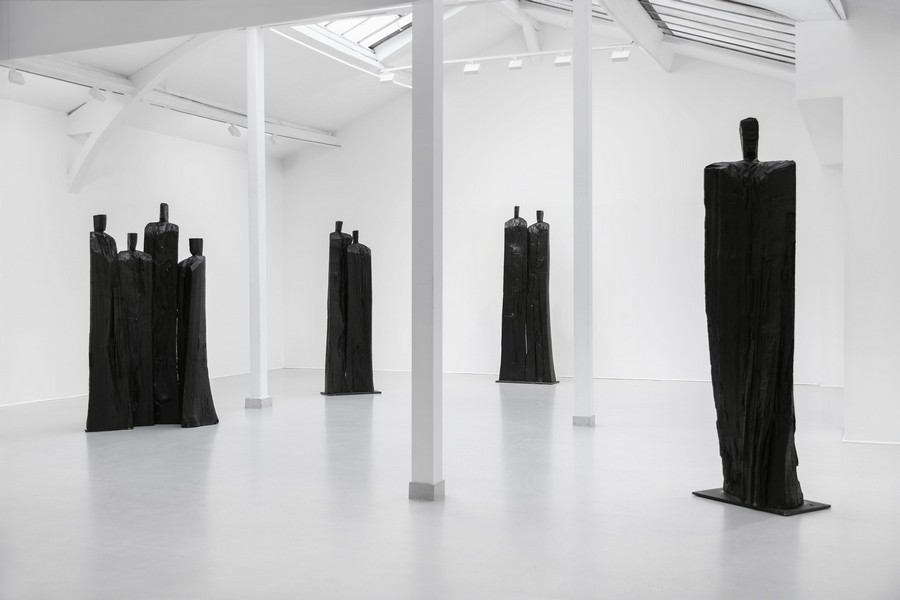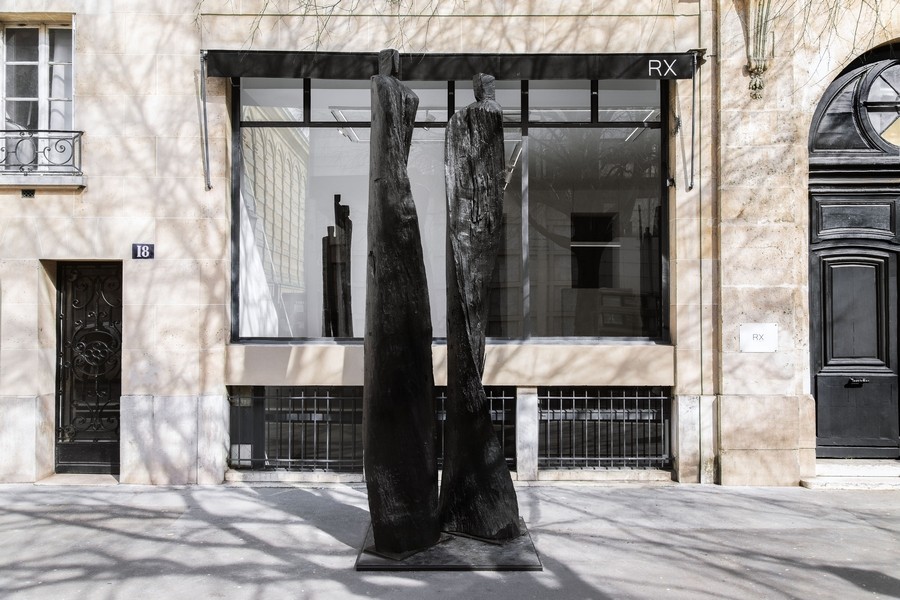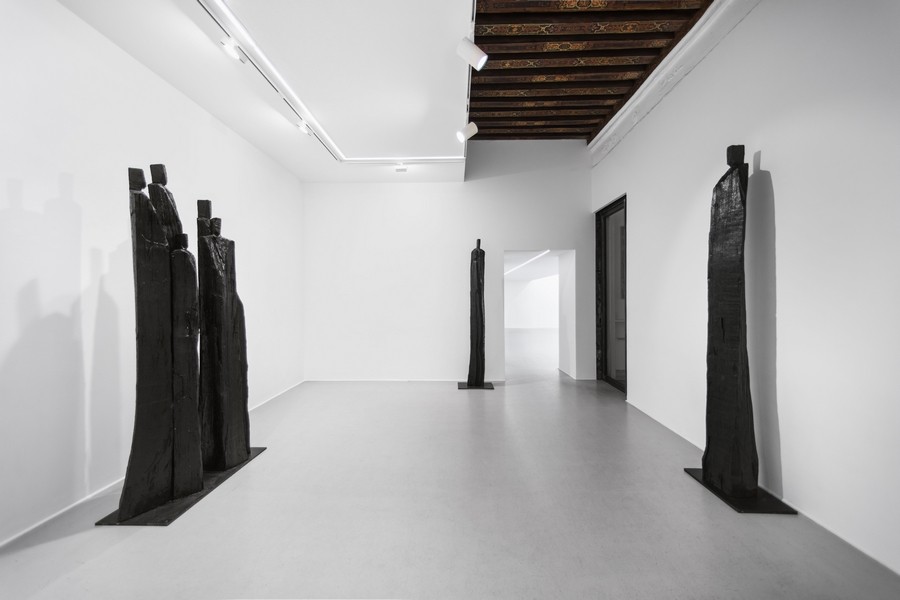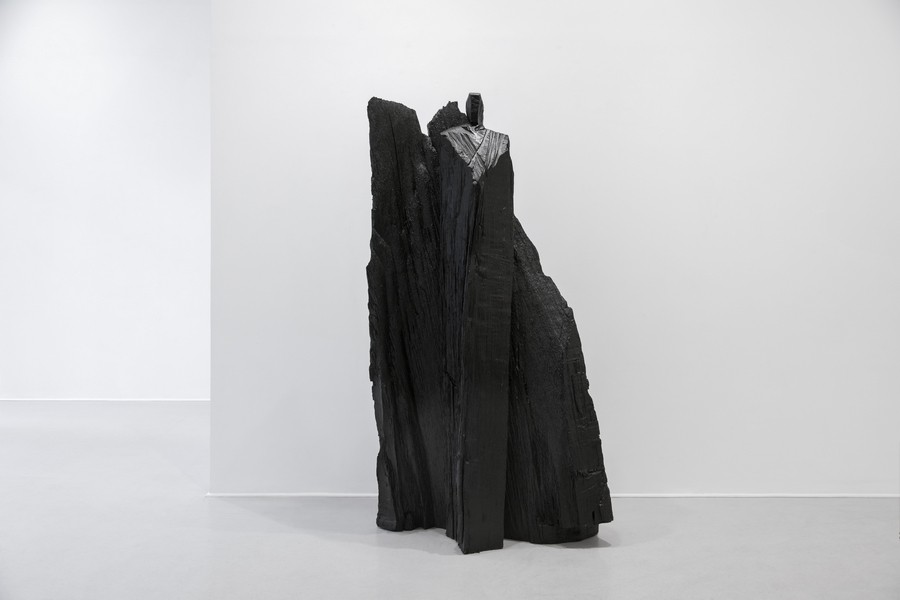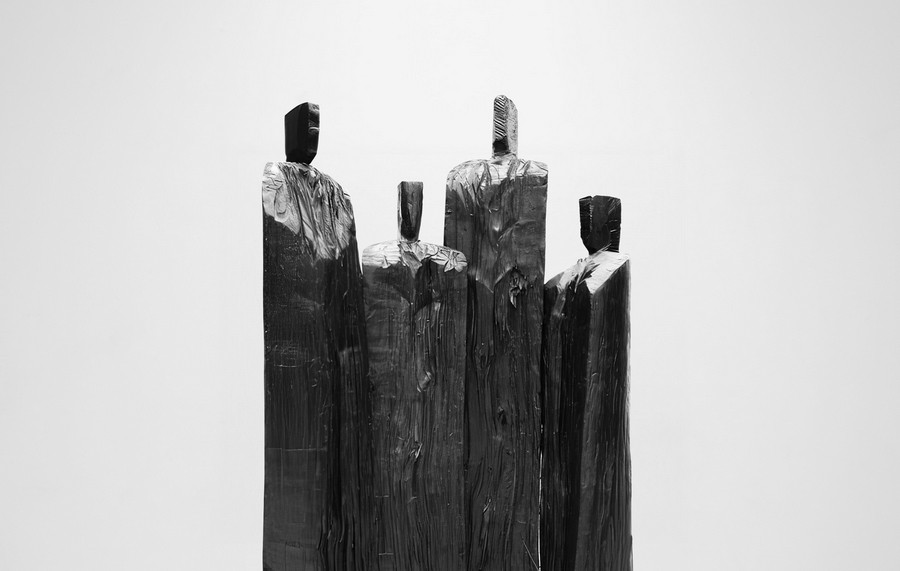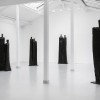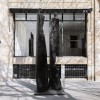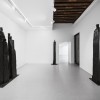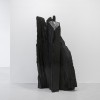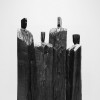For his third solo exhibition at RX&SLAG, Christian Lapie continues his search around his “benevolent guardians” sculptures, a recurring pattern of him, and push through with a desire to simplify the minimal silhouettes, in order to reinforce the idea of purity. The procession of 16 sculptures, spread through the gallery, seems to be inviting us to share a meditative and timeless moment. The title “The Uncertain Shadows” reflects the artist’s obsession with this theme, summoning altogether archetypes, the unconscious and a universal memory.
A monumental sculpture will welcome the visitor, just outside of the gallery.
Symbolic shadows
Alone or in groups, they come to us like a procession, one behind the other. Christian Lapie’s sculptures invite us to wander through the gallery while changing our perception of space. Time seems to stop, and allow it to look into ourselves. Several names come to mind to define these deep black hieratic beings that stand before us: silent guardians, benevolent messengers, millennial menhirs, deities belonging to a forgotten pantheon, protective totems, forest spirits or an assembly of ancestors. The works of Christian Lapie are all this at once and their strength is to make powerful images emerge from our memory. They challenge us and stop us. But the title of the exhibition introduces another notion: that of the shadow, a word inseparable from the artist’s career, as it returns as an antiphon in the title of exhibitions or works. Here the artist summons other symbols and meanings: the shadow is our double, our subconscious, the dark part of our psyche, one of the constituent elements of the soul for the Egyptians... “For me, this shape represents our shadow on the ground, the minimum since it is a large rectangle on which a smaller rectangle is placed. There are no legs, no arms, no gender. You can’t give it origin, time or culture.”
A universal art
Christian Lapie laid the foundations of his artistic project more than 30 years ago: his wish is to create an art «that is addressed to all, that is a universal symbolic sign and that everyone can make their own. Let it connect people with each other by creating a collective emotion.” An ambitious project that has been carried out on all continents and has always been warmly welcomed. “People see in it elements of their culture, witnesses of the past, benevolent shadows.” These works act like mirrors, where everyone can project themselves because the artist disappears. “We need to go back to the deep roots of what a work of art is.”
The original purity
To this end, Christian Lapie has approached this new series with the utmost rigour, seeking to achieve the essential purity of the work - "this is the main thread running through the exhibition" - so as to enter into a better relationship with the artwork. The choice of these charred oak woods is part of this quest, introducing a form of abstraction and transfiguration of the material. We can draw a parallel with Eastern thought, and Christian Lapie readily cites a little-known Japanese artist and Buddhist monk from the Edo period, Enkū (1632-1695). He is said to have sculpted no fewer than 120,000 effigies of Buddha in a rather crude manner, as if "carved with a billhook, the opposite of what we know of Japanese sculpture. What I have in common with him is the idea of wandering around the world (even if Japan was his only destination) to create works that meet the people, the inhabitants". Weaving links is also a way of putting fraternity back at the heart of relationships, of "bringing symbolic heights into the equation", as Régis Debray puts it. "Our great moments of fraternity all have a mythical reference of the sacred order". These words of the philosopher could be those of Christian Lapie.
Interview with Christian Lapie, RX&SLAG Paris
Exhibition "Christian Lapie. Les ombres incertaines", from March 9 to April 13, 2024
What guided you for this new exhibition at Galerie RX&SLAG?
All my gallery exhibitions are variations on the same form, like the American music of the 1960s by Philip Glass. This form is repeated, multiplied and, with the empty spaces, it creates a kind of visual music sheet. Today, I want to go to the roots, to the essentials - that's the real thread running through the exhibition. There's a certain unity in the size of the works on show at Galerie RX, barely larger than a person, presented either on their own or in groups, and some of them come from the same trunk. The idea is to achieve the essential purity of the work.
How would you explain the basis of your work?
In 1992, I was invited to exhibit at the Museum of Modern Art in Rio during the Earth Summit, along with 90 international artists. I was very enthusiastic and had created an ironic and political work. But when I got there, I was shocked by the nature, which seemed strong and generous, heavy and fragrant, impenetrable and dangerous, but also by the simple and sincere people. I wanted to create a work that would appeal to everyone, and for which neither origin nor period could be given. I wanted it to be a universal symbolic sign and to connect people with each other by creating a collective emotion. I wanted to go back to the deepest roots of what a work of art is, and create a silhouette that symbolises the human being while breaking away from stereotypes.
Why did you use trees as your raw material?
The tree is a beautiful symbol in all civilisations, linking the earth to the sky because it sinks its roots deep into the ground – which sparks a whole imaginary world because they are hidden - and because it rises higher into the sky than we do. It makes us sit up straight.
You didn't choose just any trees, but those belonging to a forest in your region, Champagne-Ardenne. Could you explain why?
In 1979, after studying at the Beaux-Arts in Paris, I settled in Champagne-Ardenne in an old barn that belonged to my parents, and before that to my grandparents and great-grandparents. All these generations have experienced one of the wars, 1870, 1914-1918 or 1939-1945. What's more, ever since I was a teenager and wanted to be an artist, I felt I had to extract things from deep inside me and from this area of violence and carnage. It was important for me to include in my work these wounded and resilient trees, which have received shrapnel from shells. Their memory is a reminder of historic moments.
How do these splinters appear after so many years?
A diffuse stain appears on the split part of the tree, a bit like Indian ink on watercolour paper.
What are the important stages in your work?
There are 3 phases that generate a lot of emotion. First of all, choosing the trees is a very powerful and intuitive moment. I'd even go so far as to say that it's a real treat. Then the trunks are split by hand: they open in two and I immediately see how I'm going to trim them to free up the silhouettes and give them back what I consider to be their initial nature. The final phase consists of straightening them up and bringing them together to form groups. It's at this point that the cycle takes on its full meaning, from searching for the trunks like a hunter-gatherer - just like when you go looking for wild berries or mushrooms in the forest, you browse, you look, you search - to positioning them in an environment. I then give them another reason for being.
Putting several figures together allows me to play with the spaces between them, which could be silences, as in music.
What attracts your attention when you choose the trees?
When I look at them, I can imagine how man-trees emerge once the trunk has been split. They have a certain bearing, a certain elegance, a certain relationship to verticality, slight twists or not, the impression that they would split into 2 or 3, which would make it possible to create groups from a single trunk. The criteria are altogether formal, technical and emotional. The emotion that guides my choices of trees is indescribable.
Are these trees intended to be cut?
Yes, I only buy authorised trees, sold at auction to sawmills by the Office National des Forêts or the local authorities. Oak felling in French forests is never clear-cutting; it's a meticulous job for the picker. Certain trees are designated, and then they have to be felled without damaging the others. This pruning allows the natural regeneration of oak forests, since it is the fallen acorns that give rise to new oaks.
What role do drawing and painting play in your work?
I try to find in drawing what I do in sculpture. I'm only showing 2 tar paintings on paper in the exhibition, a material that I find very beautiful, thick and that allows for some very nice drips. I use it as a stain that I let run and which becomes like the image of a split tree.
You've installed your sculptures all over the world. Do you get different reactions in different countries?
When I set up this project, I wanted to have this relationship with other cultures, so that my works could be installed anywhere on earth. I've done this many times, and people see them as elements of their culture, as witnesses to the past, as guardians, as benevolent shadows, and I'm very happy about that. As far as collectors and institutions are concerned, people are surprised that it works as they had imagined or read about. They all tell me that they have the impression that the sculptures have always been there! As if they were there and we just didn't see them.
Is the relationship with collectors important?
Yes, the human part is very important to me, so in 95% of cases, even for small pieces, I will install the works in the collector's home myself. It's also important to help them find the right location, one that's not the most obvious, so that people can discover it around a bend in the road, as if it were hidden away, and so be surprised.
Could you share a story associated with a particular commission?
After the storm of 1999, the owners of the Château de L'Abrègement, in Bioussac in the Charentes region, asked 4 artists to create works from the trees that had been destroyed, to get beyond the emotion of destruction, to make it resilient [60,000 sessile oaks were replanted and the "querceraie" houses a collection of over 100 varieties of oak, editor's note]. The other artists were Andy Goldsworthy, Antony Gormley and Joël Shapiro. It was a very powerful experience, a rebirth and a rebound from a tragic event.
